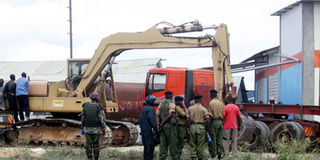Construction of Sh40bn Dongo Kundu road to begin mid year

Police guard a bulldozer in Miritini outside a transport company's yard in 2012 after chaos erupted as an investor blocked police from executing court orders that authorised the demolition of the facility to pave way for the construction of the Dongo Kundu bypass. PHOTO | FILE
What you need to know:
- The bypass will connect areas such as Miritini, Mwache, Tsunza, Dongo Kundu and Kibundani
- Construction of the bypass was to have begun in December 2012, according to an outline prepared by the Japanese International Cooperation Agency
The first steps have been taken to build the Sh40 billion Dongo Kundu bypass at the Coast with eviction notices issued to land owners along the road.
It will be in three phases and is expected to be completed in four years, according to Transport and Infrastructure Principal Secretary John Mosonik.
“We are now at the design stage, which should be complete towards the end of February. Thereafter, we expect to float the tenders some time in March, with actual construction starting in the third quarter of this year,” he said in an interview with the Sunday Nation.
The bypass will connect areas such as Miritini, Mwache, Tsunza, Dongo Kundu and Kibundani. In addition there will be another 5.7 kilometre Kipevu link road, to significantly ease traffic congestion in the Mombasa area.
A new container terminal will also be built. A free port and a thermal power plant are also planned for the southern part of Mombasa.
The Japanese government will lend Sh29 billion of the Sh40 billion at a rate of 1.2 per cent. The loan is to be repaid in 30 years with a grace period of 10 years.
According to Mr Mosonik, the most difficult part will be building the bridge connecting Mombasa Island to the mainland. That alone is expected to take about two years with the other two phases expected to take approximately a year each. Construction is scheduled to be completed in 2018.
ESCALATED COST OF BUSINESS
Construction of the bypass was to have begun in December 2012, according to an outline prepared by the Japanese International Cooperation Agency, but was delayed due to bureaucratic processes. (READ: Construction of road to South Coast to start)
Mr Mosonik said compensation for land owners are being worked out which he said is time-consuming and costly.
The development of key infrastructure in the area to link the island to the mainland is expected to speed up the expansion of Mombasa to the mainland.
Inefficiencies caused by congestion and traffic jams have escalated the cost of doing business at Mombasa Port.
The growth of Mombasa’s population has also stretched infrastructure to the limit.
“Traffic capacity has been a challenge, especially at the connecting points between the island and mainland. The ferry at Likoni channel is the only transport option to the South Coast and is overwhelmed by huge traffic demand, which wastes time,” Jica says in its project outline.
Coupled with the construction of the standard gauge railway that is to link Mombasa to Uganda and Rwanda, Mombasa’s function as the gateway to East Africa will be greatly enhanced. It links landlocked countries of Uganda, Rwanda, Burundi and South Sudan.
The new road is also expected to diminish the lingering threat of the proposed $11 billion port Tanzania plans to build with Chinese aid at Bagamoyo on the country’s northern coast.
With a road to Tanzania as part of the project, cross-border trade is bound to pick up.
The National Land Commission has issued eviction notices to property owners.
In a Gazette notice on January 24, the commission released an eviction notice and a compensation plan. In line with the infrastructure development in the country, especially on road, the government has come under growing pressure because of inadequate external funding and ballooning recurrent expenditure.
“Initially, there is donor and government funding but once we finish the project, we will incorporate public-private partnerships,” Mr Mosonik said.
There are more than 12 roads under way across the country as the government enhances efficiency in road transport, thereby bringing down the cost of doing business.




